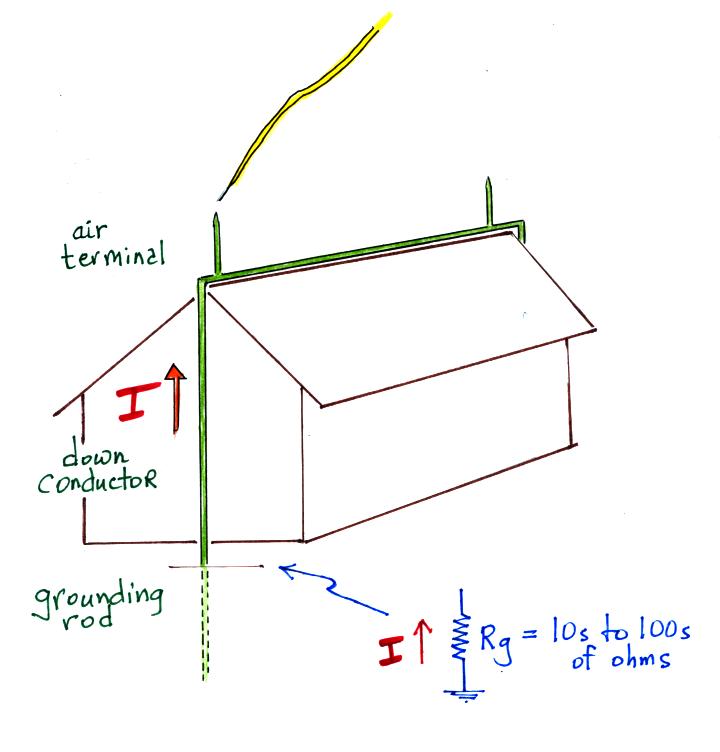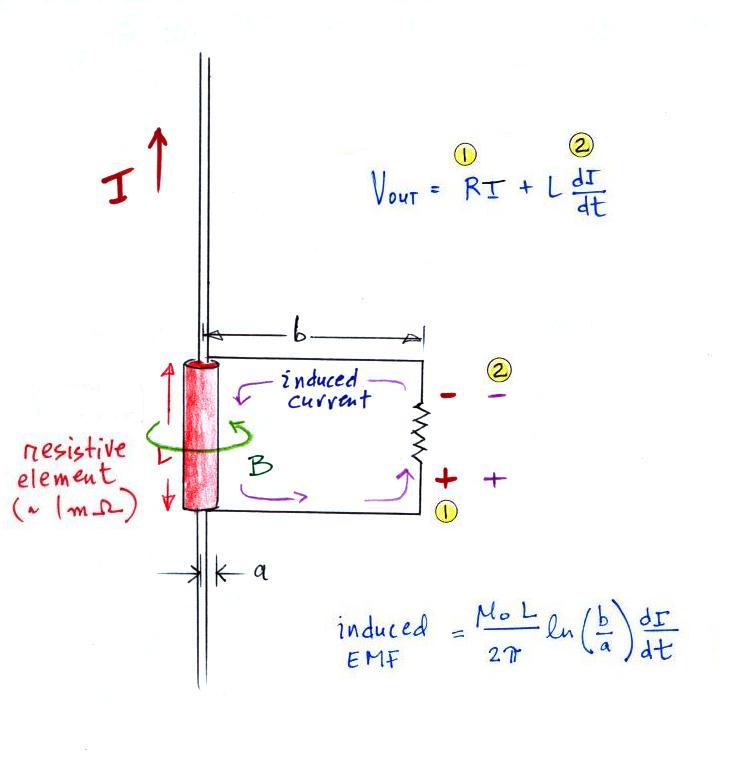Tuesday March 21, 2017
Today we will begin a discussion of lightning return stroke
currents. We'll start by looking at what current properties
or parameters are of most interest from a lightning
damage/protection point of view. Return stroke current is
now routinely measured in triggered lightning. Before that
measurements of currents were made in strikes to instrumented
towers. We'll look at the kinds of sensors that can be
used. In a future lecture we'll look at how we might
determine return stroke currents from remote measurements of
lightning electromagnetic fields.
Lightning return stroke "engineering parameters"
Lightning return stroke currents cause different kinds of
damage. Here we'll examine what we need to know about
lightning return stroke current characteristics in order to
predict the level of damage they may cause and to better be able
to design effective lightning protection.
Peak current. Peak current is of
interest when lightning strikes an object that presents a
resistive load to the lightning current. M.A. Uman uses the
example of a phase conductor on a power line in his book "The Art
and Science of Lightning Protection" (p. 33). When lightning
strikes the line, pulses of current will travel outward away from
the strike point much as a signal travels along a long
transmission line. Power lines, apparently, have a
characteristic resistive impedance of about 500 ohms.

An electric field of about 3 MV/m breaks down air (at sea level
pressure). A 7.5 MVolt over-voltage thus could be high
enough to spark across to a ground wire or to one of the other
power lines. This produces a "fault" and would most likely
cause a circuit breaker to trip and stop the flow of current.
Lightning rods on the house sketched below are connected to ground
rods that are driven into the soil.

Depending on the soil type and moisture content, the ground
resistance can range from a few 10s of ohms to a few 100s of
ohms. A peak current of 30,000 Amps would produce a voltage
of 750,000 volts across 25 ohms and 7.5 MVolts across 250
ohms.
The latter value almost certainly would be enough to spark across
to nearby plumbing, electrical wiring, or some other part of the
structure . The lightning rod should be electrically
connected (bonded) to nearby water pipe and vent pipes to prevent
this kind of occurrence. When everything is electrically
connected, the whole structure would "float" up to 7.5 MVolts, but
there wouldn't be any potential differences or arcing through or
between different parts of the structure.
Peak
dI/dt
The peak value of the return stroke current derivative is of
interest if lightning strikes something with an inductive
impedance.
The straight "down conductor" in the sketch above has an
impedance, L, of roughly 1 microHenry per meter. Wires with
bends will have higher inductance. Lightning return strokes
(both 1st and subsequent strokes) have peak current derivatives
values of about 100 kA/μsec (1011
A/sec). The voltage produced here will be L x dI/dt = 1011 A/sec x 10-6
H = 100,000 volts for every meter of the down conductor.
Perhaps a more serious problem is that the lightning dI/dt will
produce a time-varying magnetic field that can couple into nearby
electronics (loops are of primary concern).

A current moving along a long vertical conductor as shown above
will generate an azimuthal magnetic field, B. Faraday's law
of induction states that an electromotive force (EMF) or potential
difference (ΔV) will be induced across the open ends of a nearby
circuit when the magnetic flux through the crossectional area of
the circuit changes with time. In the simplest case B might
be uniform across the area of the circuit. Then ΔV
will just be equal to the area of the circuit times dB/dt.
The time derivative of B in turn depends on the time rate of
change of the current, dI/dt. Large lightning dI/dt values
can induce damaging voltages in sensitive electronics.
Q(charge transfer = ∫ I dt)
The time integral of the return stroke current gives the
total charge transferred during the strike. This apparently
determines (and this is something I don't really understand)
whether the lightning current will burn through a sheet of metal
(such as a metal roof or the thin metal skin of an airplane).
The lightning will burn through the metal sheet unless heat can
be carried away from the strike point quickly enough. Not
as much charge would be needed to burn through thin sheets because
they won't be able to dissipate heat as quickly as thicker sheets.
Here it is the continuing currents that are of concern because
that is where most of the charge transfer occurs. I like to
think of the lightning strike resembling an arc welder in this
kind of a situation.
Action integral ( ∫I2
dt )
The last parameter of interest is called the action integral
The instantaneous power dissipated by a resistive load is
so the energy deposited is R times the action integral
This will cause heating, melting, even vaporization of
materials with low electrical conductivity that are struck by
lightning. Lightning can vaporize the sap in a tree, for
example, and cause the tree to explode.
Measuring return stroke current
Some of the earliest estimates of return stroke peak currents
come from measurements of the residual magnetism in nephelitic
basalt (whatever that is) near trees that were struck by lightning
(within centimeters of the tree perhaps). The data were
published by Pockels in 1897 & 1898 (the publications would be
interesting to look at, but they are in German).
Pockels had determined, in laboratory experiments, that the
magnetization of the basalt depended on the peak current value
alone and wasn't affected by the shape of the current waveform or
its duration.
The sketch below shows a klydonograph. A high voltage will
produce a Lichtenberg
figure on the film.
The diameter of the pattern depends on the peak voltage which can
then be related to peak current if the impedance of the
arrangement is known.
Different patterns are produced depending on the polarity of the
applied voltage. Here's an
informative web site with some interesting historical
background on Lichtenberg figures. A Lichtenberg
figure like pattern is often burned into the grass on golf courses
when lightning strikes the flag on a green. You'll find a
particularly good example from a strike in Tucson here.
The figure below, which shows surface arcing produced by
a return stroke triggered in Alabama, gives you some appreciation
for why this occurs (from V.A. Rakov, "Parameters of
Rocket-Triggered Lightning," available at http://www.lightning.ece.ufl.edu/PDF/Rakov%20%5B2010%5Da.pdf,
see also Rakov (2010) in the reference list at the end of these
notes).
The subsequent stroke that produced this surface arcing had a
peak current of 30 kA; the return stroke channel is outside the
field of view of this photograph.
At one time "magnetic links" were used extensively by the
electric power industry to estimate peak currents in lightning
strikes to power lines.
A magnetizable material is positioned perpendicularly to a
straight conductor. Often two or more links are
mounted with different orientations and at different distances
from the conductor. The figure below (a follow up to a
question in class) shows how you might be able to determine the
peak magnetic field that occurred during a lightning strike.
One end of the link is mounted a known distance, r1,
from the conductor. The link is taken back to the lab after
a strike and you determine that the link material was magnetized
out a distance r2 from one end. You know that it
takes a certain magnetic field intensity, Bc, to magnetize the
link material. At distances r < r1 + r the field must have been greater than Bc. At
distances greater than r1 + r2 the
field must have been less. The field must have exactly Bc
at r = r1 + r2. You could then
determine the peak current that would be needed to produce Bc at
a distance r.
An inexpensive version of a magnetic link was
at one time used at the Kennedy Space Center to estimate peak
currents in strikes to certain launch facilities. A strike
to a launch tower would probably require time consuming and
expensive testing to ensure the facility hadn't been damaged and
was still fully operational.
A loop of prerecorded magnetic tape (on a plastic support and
sealed inside a length of PVC pipe) was positioned
perpendicularly to conductors that might carry large amplitude
lightning currents. A portion of the signal on the tape
would be erased by the magnetic fields produced by lightning
currents. The magnetic tape wouldn't be removed and analyzed
unless the photo bulb had flashed, indicating that a lightning
strike had occurred.
A wire loop placed close to a straight conductor (the vertical
conductor could be the lightning channel itself) can be used to
determine the current derivative.



















